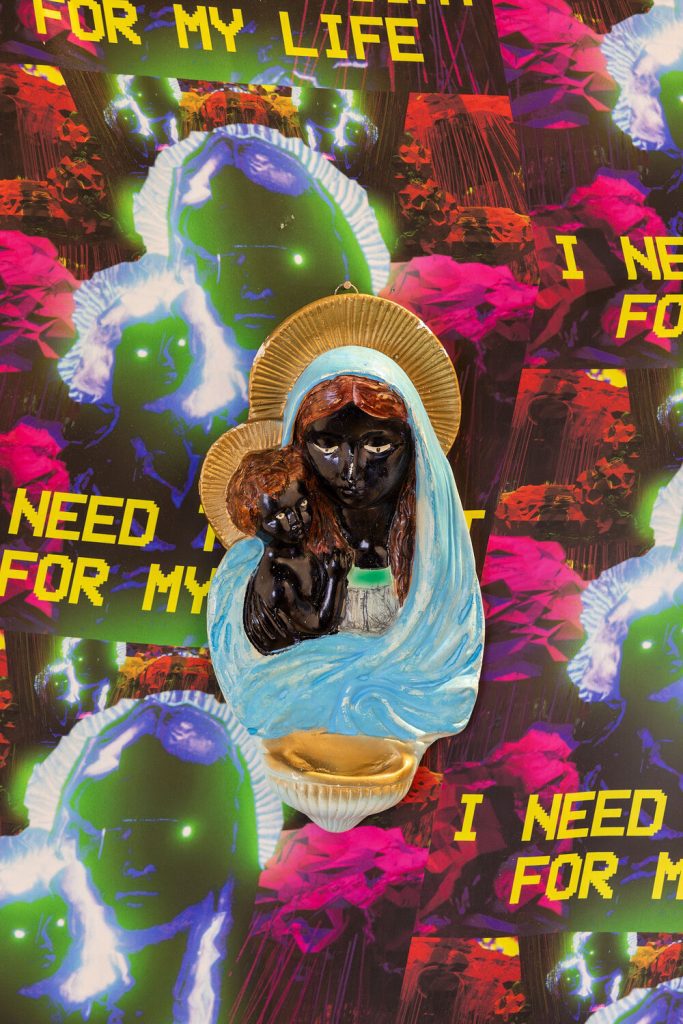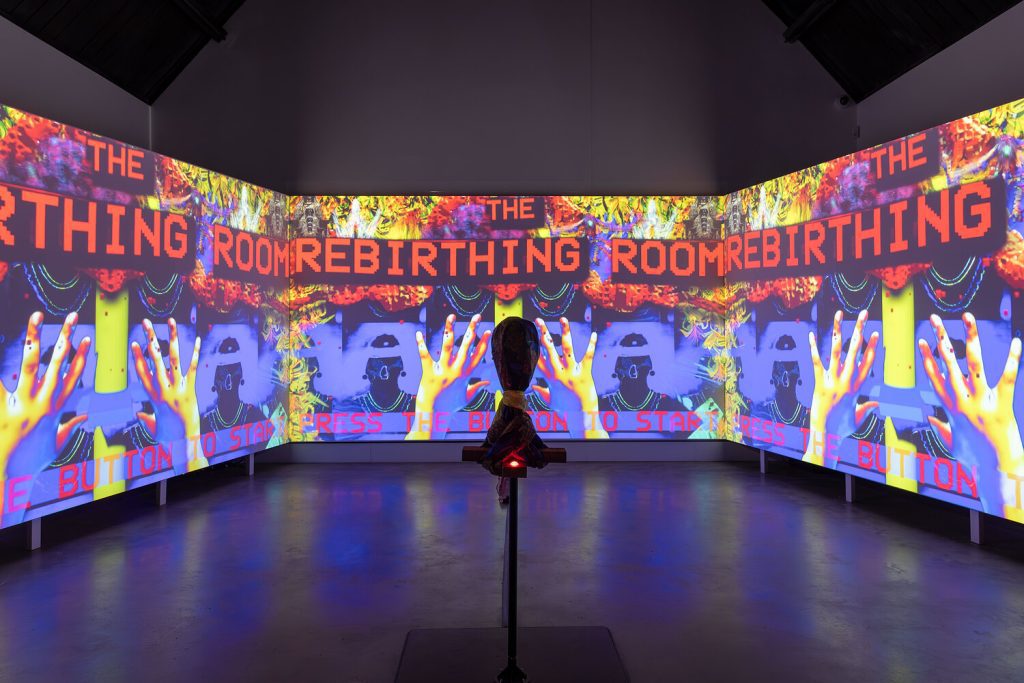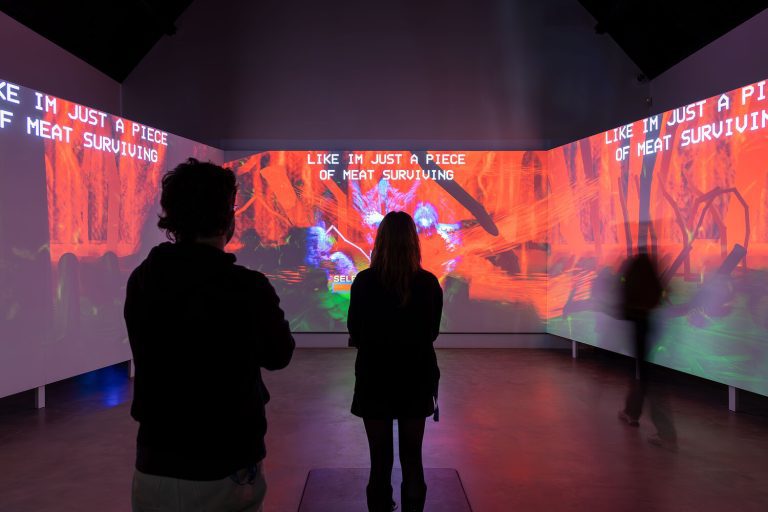Meet Danielle Brathwaite-Shirley, a Berlin-based multimedia artist, dedicated to archiving the Black Trans experience. Through the lens of technology, Brathwaite-Shirley creates vivid environments, offering a profound centering of Black Trans bodies – those present, those departed, and those lost to the annals of history. This is not merely for observation; it’s a journey into the soul of human connection and remembrance where the ordinary expectation of enjoying art transforms into a powerful experience, urging you to confront your emotions.


hube: Animation, sound, performance, and video games are diverse mediums you use to communicate the experiences of being a Black Trans person. How do you navigate the challenges and possibilities each medium offers, and how do they contribute to the overall narrative you’re crafting?
Danielle Brathwaite-Shirley: I conceptualize ideas first and then choose the appropriate medium, even if it means I need to spend time acquiring new skills. Proficiency in a particular medium is not my primary concern; instead, I focus on what suits the idea and serves the narrative. Each medium has a purpose, be it the stillness of paintings conveying amazing images or the challenges presented by sculptures with their inherent distance. This also extends to video game engines and the Internet, which I consider as integral to my work as traditional forms of art.
However, for me, the audience itself is the main medium. I want to provoke emotional responses, not merely create aesthetically pleasing art. My goal is to transform art and influence how the audience interacts with it. In an art space saturated with detached consumption, my intention is to break through this barrier and offer a new experience for people.
I do not want art to be out there for just conceptualising. I want the audience to go on a personalised journey through the video game. For it not to view the artwork safely, but feel responsible for the choices they make in the game. I’m not trying to make the audience step into my shoes and understand Black Trans people, I am not interested in that. Instead, I want everyone to walk away with a unique experience based on how they play.
h: Your practice involves intertwining lived experiences with fiction to imaginatively retell stories. How do you approach the balance between personal narratives and the creation of fictional elements within your work?
DBS: When creating textures or environments, I typically use real images, turning them into elements like grass or wall textures. For instance, the 3D environments, 2D elements, and sculptures all find their origins in actual real people rather than arbitrary designs. I am not trying to recreate the story they told me. I capture the essence of a person’s story by using a picture of their skin as the foundational element; I’m an archivist in my own way but definitely not a traditional one.
Listening to someone’s life story provides me with a sense of who they are, even though it’s not a comprehensive view. My goal is to transfer this essence into the game, like capturing a soul fragment into the work.
The process involves extrapolating a single story, often small in scale, into an entire world and environment. If, for instance, the storyline is about someone’s upbringing, I explore elements that could have supported them during that time. Maybe they needed someone to hold their hand when a police person was approaching? Crucially, the goal is to avoid recreating trauma. While a world could be built around a negative experience, the focus is not on the traumatic event itself.
This dichotomy places visitors in a unique position, experiencing a new environment for a limited time, challenging them to navigate choices and emotions. The work, while rooted in the experiences of Black Trans individuals, invites everyone to relate to universal fears and anxieties.
I intentionally avoid the artificial representation often found in mainstream media. My focus is on creating relatable experiences. The abstract storytelling approach ensures a more personal and authentic encounter for each visitor.
h: Playable games have the potential to reach a diverse audience. How do you see the interactive nature of your games contributing to a broader understanding and appreciation of the Black Trans experience?
DBS: I don’t believe the interaction with my work provides a broad understanding of Black Trans experiences. It’s not intended as an educational tool; I’m not here to teach you about Black Trans individuals, their words, appearance, or identity.
My starting point is crafting the work for those it represents, archiving their stories in a way, that parallels the writings of Bell Hooks or Audre Lorde. I guide you through an environment where you must make choices that carry a sense of responsibility. Visitors often feel judged as they navigate these decisions in a public setting, adding tension and pressure. The aim is to instil a sense of responsibility, making you aware that your actions can impact others. There are no neat conclusions; instead, you leave questioning your choices and wondering if you’re failing yourself or others.
Art, in my view, should provoke genuine emotions and potentially encourage change, making individuals better for themselves. While I may not be certain of achieving that yet, sparking thought is a very important step in the process.
h: The 12-month residency with Studio Voltaire seems like it was an incredible opportunity. Could you share some insights into how this project came about and discuss the impact it had on the development and scope of the exhibition and public programme you worked on during your residency?
DBS: The residency with Studio Voltaire came about in 2022. Back in 2021, after hustling through my first solo shows, I was knee-deep in creating different works. Two shows, two different vibes – one took the audience on a trip tracing your ancestors, dealing with the history of slavery. Were your ancestors the ones who carried or were they carried across the sea? The other was SHE KEEPS ME DAMN ALIVE, diving into anti-violence and the allure of guns in video games.
Then Studio Voltaire popped up during the GET HOME SAFE show. Meta, excited about their headsets and media quests, saw a chance to join forces. Now, headsets aren’t exactly party-friendly, so we spent the residency figuring out how to make VR a group experience. Motion capture from the headset turned into a tool for creating, not just an accessory.
VR is usually this personal thing, but I wanted to bring that intimacy into a room. Make it a shared vibe. The final show was not about VR, but it soaked up the insights from that journey. It’s about talking about problems a lot of people have to deal with in real life – addiction, self-doubt, personal growth. Mixing the virtual and physical, creating a space that’s all about connecting with yourself and others.

